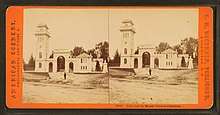Mount Vernon Cemetery (Philadelphia)
Mount Vernon Cemetery is a historic cemetery located at 3499 West Lehigh Avenue in Philadelphia, Pennsylvania.
 Mount Vernon Cemetery Gatehouse | |
| Details | |
|---|---|
| Established | 1856 |
| Location | 3499 West Lehigh Avenue, Philadelphia, Pennsylvania |
| Country | United States |
| Coordinates | 39°59′58″N 75°11′06″W |
| Type | private |
| No. of graves | 18,250 |
| Find a Grave | Mount Vernon Cemetery |
History


The cemetery was established on February 28, 1856 and is located directly across Ridge Avenue from Laurel Hill Cemetery.[1]
The property was originally part of the colonial estate of Robert Ralston named Mount Peace. Another portion of the estate was purchased by the Oddfellows organization for Mount Peace Cemetery.
John Notman, the architect of Laurel Hill Cemetery's Italianate gatehouse was hired to design a larger and grander gatehouse for Mount Vernon Cemetery which was completed in 1858.[2]

In 1864, the Gardel Memorial was added to Mount Vernon. It is a memorial to Julia Hawks Gardel, who died in 1859 while traveling in Syria.[3] Her husband, Bertrand Gardel commissioned Philadelphia architect Napoleon LeBrun and Belgian sculptor Guillaume Geefs to create a 25 foot pyramid made of sandstone, marble and imported granite. The front of the pyramid is adorned with large marble statues which represent the continents of Asia, Europe and Africa to depict Julia's love of travel. Two statues above the pyramid door depict Hope and Faith holding a carved relief of Julia. The statue atop the pyramid represents America surrounded by emblems of the physical sciences.[4] The memorial cost $36,000 which is the equivalent of about $2 million in current dollars. Bertrand Gardel died in 1895 and is interred in the vault beneath the memorial with his wife.[5]

In 1867, the Second Presbyterian Church burial ground on Arch Street was closed and 2,500 bodies were reinterred at Mount Vernon many from the 1700s including several Revolutionary War heroes.[5]
The Drew family lot at Mount Vernon contains generations of the Barrymore family. John Barrymore left in his will that he wished to be buried in the Drew family lot but was originally interred in the Calvary Cemetery in Los Angeles, California. In 1980, his son John Barrymore Jr. had his father's remains removed from the family mausoleum, cremated and reinterred in Mount Vernon Cemetery.[6] His grave was unmarked until 1992, when fans had a stone installed which had engraved upon it, "Alas poor Yorick" in a reference to his stage performance of Hamlet.[7]
The cemetery is not abandoned, however no lots have been sold since 1968[8] and it has become heavily overgrown. Mount Vernon is not open to the public.[9] The owner requires an appointment be made for visitations 24 hours in advance[10] and only for people who have a family plot in the cemetery and know the location.[3]
Notable burials
- John Barrymore (1882-1942), stage, screen and radio actor
- Maurice Barrymore (1849-1905), stage actor
- George C. Burling (1834-1885), Union Army officer during the U.S. Civil War
- Georgiana Drew (1856-1893), stage actress and comedian
- John Drew (1827-1862), stage actor and theatre manager
- John Drew, Jr. (1853-1927), stage actor
- Louisa Lane Drew (1820-1897), actress and theatre owner
- Louise Drew (1882-1954), stage actress
- Sidney Drew (1863-1913), member of the Mr. and Mrs. Sidney Drew comedy team
- Sidney Rankin Drew (1891-1918), actor and film director
- Peter Stephen Du Ponceau (1760-1844), linguist, philosopher and jurist
- Christian Febiger (1749-1796), American Revolutionary War commander
- Charles Albert Fechter (1824-1879), actor
- Charlie Householder (1854-1913), professional baseball player
- William Churchill Houston (1746-1788), New Jersey delegate to the Continental Congress
- Lawrence Johnson (1801-1860), printing stereotyper and type-founder
- Judy Lewis (1935-2011), actress, writer, producer and therapist
- Dorothy McHugh (1907-1995), actress known for "I've fallen and I can't get up" catchphrase from a television commercial[11]
- Henry Myers (1858-1895), professional baseball player
- Lawrence Saint (1885-1961), stained glass artist
- Maria Louise Sanford (1836-1920), educator
- Alfred J. Sellers (1836-1908), Medal of Honor recipient
- Bill Sharsig (1855-1902), Major League Baseball co-owner and general manager
- Jonathan Bayard Smith (1742-1812), Pennsylvania delegate to the Continental Congress
- Jake Virtue (1865-1943), professional baseball player
- Pelatiah Webster (1726-1795), colonial merchant and author of short essays on finances and the government of the United States
Footnotes
- Scharf, John Thomas (1884). History of Philadelphia, 1609-1884. Philadelphia: L.H. Everts & Co. p. 2360. Retrieved 23 August 2019.
moriah.
- Webster 2014, p. 143.
- "Roaming with the Roxborough Runner: Mount Vernon Cemetery". www.nwlocalpaper.com. Retrieved 7 September 2019.
- "Mrs. Julia Hawks Gardel". www.findagrave.com. Retrieved 20 September 2019.
- Webster 2014, p. 145.
- Keels, Thomas H. (2010). Wicked Philadelphia: Sin in the City of Brotherly Love. Charleston, SC: The History Press. ISBN 978-1-61423-105-9. Retrieved 21 September 2019.
- Keels 2003, p. 54.
- Herr-Cardillo, Starr. "A Fine and Public Space: Preservationists Revive Philadelphia's Historic Cemeteries as Vibrant Spaces for The Living". www.hiddencityphila.org. Retrieved 7 September 2019.
- "Mount Vernon Cemetery - Philadelphia, Pennsylvania". www.localcemeteries.net. Retrieved 7 September 2019.
- "Mount Vernon Cemetery". www.findagrave.com. Retrieved 7 September 2019.
- "Dorothy McHugh". www.findagrave.com. Retrieved 22 September 2019.
References
- Keels, Thomas H. (2003). Philadelphia Graveyards & Cemeteries. Arcadia Publishing. ISBN 0-7385-1229-X.CS1 maint: ref=harv (link)
- Webster, J.P. (2014). Vanishing Philadelphia: Ruins of the Quaker City. The History Press. ISBN 978-1-62585-134-5.CS1 maint: ref=harv (link)
External links
| Wikimedia Commons has media related to Mount Vernon Cemetery. |
- Mount Vernon Cemetery at Find A Grave
- Video of Mount Cemetery grounds